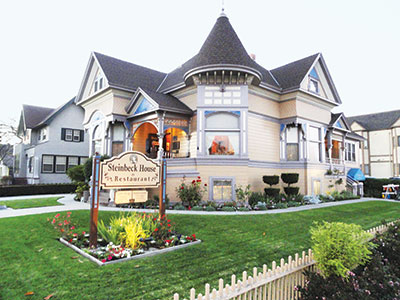California tours: Steinbeck’s Salinas and Monterey County showcase the natural world

The Salinas Valley in northern California runs for about 100 miles from Salinas in the north toward King City in the south of Monterey County and beyond.
To the east are the Gabilan Mountains, while the Santa Lucia Mountains are on the west.
Writer John Steinbeck was born in Salinas in 1902, knew the valley well and described it with precision and love in his books.
Today, groups can learn more about Steinbeck at the National Steinbeck Center in Salinas, discover the valley’s agricultural bounty and view the area’s wildlife.
Steinbeck eventually moved to New York, won the Pulitzer Prize for his 1939 novel The Grapes of Wrath and received the Nobel Prize for Literature in 1962. He died in 1968 and is buried in Salinas at the Garden of Memories Cemetery.
Colleen Bailey, the executive director of the 29,000-square-foot National Steinbeck Center, said it was the largest literary museum in the United States.
“What we’re known for the Steinbeck Exhibition Hall,” Bailey said.
The 6,000-square-foot hall includes six themed galleries that present the life and literature of Steinbeck.
Also part of the center are changing art and cultural exhibits with a variety of educational and public programs.
Many of Steinbeck’s novels and short stories are set in the Salinas area.
“People in Salinas would recognize just about everyone in the books,” Bailey said. “Steinbeck was not popular here. He was kind of radical. He captured the beauty of the Salinas Valley, especially in East of Eden.”
In 2014, the center celebrates the 75th anniversary of Steinbeck’s novel The Grapes of Wrath. New exhibits, including material from an 11-day trip in late 2013 that re-created the fictional Joad family’s journey to California from Oklahoma, will surface as part of the 2014 Steinbeck Festival, May 2–4 at the center.
Steinbeck’s shadow can still be seen in Salinas. Cherry Bean Coffeehouse is in the same building and location as Steinbeck’s father’s feed store. The writer ate at Sang’s Cafe, across the street from the National Steinbeck Center, although it was the Rodeo Cafe when he knew it.
Groups can have a meal at Steinbeck’s birthplace and boyhood home, an 1897 Queen Anne-style Victorian in Salinas. The Steinbeck House serves meals featuring fresh produce from the fields of the Salinas Valley.
Produce producer
Evan Oakes, an agricultural scientist with the University of California Cooperative Extension, also owns Ag Venture Tours. On his ag and wine driving tours of the Salinas Valley he gives an overview of the history of agriculture in the valley and current practices, such as planting, irrigation, harvesting, organic farming and farm labor.
While Oakes takes small groups out in a van, he will also do tours as a motorcoach step-on guide.
The Salinas Valley, per acre, is the most expensive land in the world, Oakes said, and economics dictates growers must grow crops that are high in value.
“The Salinas Valley grows 80 percent of the lettuce in the United States and Canada,” Oakes said. “We grow about half of the U.S. strawberries.”
Once the vegetables are harvested, they must be cooled. “The goal is to get the produce into the cooler within two hours of harvest,” Oakes said. “They don’t mess around. They work these coolers 24/7.”
As he conducts a tour, Oakes points out fields of asparagus, artichokes, broccoli, cauliflower and celery.
Oakes often starts his ag tours at Pezzini Farms’ roadside stand in Castroville. The Pezzinis have been growing artichokes here since 1929, when Valentine Pezzini emigrated from Italy.
Gina Nucci, director of healthy culinary innovation at Mann Packing Co., said the Dust Bowl migrants were the first to people who really saw the agricultural potential of the Salinas Valley.
“We’re known for broccoli,” Nucci said. “Just like broccoli is good for you, it’s good for the soil.”
The Farm is an agricultural education center and local farming business just outside of Salinas that offers 45- to 60-minute group tours of its operation.
On the water
Groups can see a different slice of nature on a cruise in Elkhorn Slough, one of the largest areas of undisturbed wetlands in California.
Yohn Gideon offers cruises on the Elkhorn Slough Safari for larger groups, while Brian Ackerman, owner of Whisper Charters, can take six on Selkie II, a boat powered by electricity.
More than 300 species of birds, 100 species of fish and 400 species of invertebrates have been identified in the Elkhorn Slough.
Kayakers also can explore the slough on guided or self-guided tours.
Sanctuary Cruises offers cruises on Monterey Bay looking for whales and other marine life.
The Monterey Bay National Marine Sanctuary, established in 1992, is the largest of 13 federally protected marine offshore areas in the U.S. The sanctuary holds many species of marine life.
Monterey Bay Aquarium opened in 1984 on the site of a sardine cannery in Monterey.
The aquarium’s approach to showcase marine communities in the bay, rather than individual species, was influenced by the work of Edward “Doc” Ricketts, a marine biologist and a close friend of Steinbeck. The pioneering 300,000-square-foot aquarium has a living kelp forest and shares everything from the playfulness of sea otters to the beauty of graceful jellies.
Destination Salinas
(831) 435-4636
www.destinationsalinas.com
Ag Venture Tours
(831) 761-8463
Elkhorn Slough Safari
(831) 633-5555
www.elkhornslough.com
Monterey Bay Aquarium
(831) 648-4800
www.montereybayaquarium.org
National Steinbeck Center
(831) 796-3833
www.steinbeck.org
Sanctuary Cruises
(831) 917-1042
www.sanctuarycruises.com
Whisper Charters
(831) 239-2914
www.whispercharters.com



Follow Us!